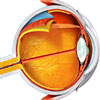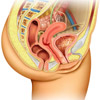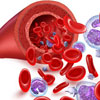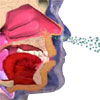Introduction to the innate immune system

Physical barriers to infection
The major defences of the innate immune system are those that stop the infection from getting into the body in the first place. If they can do this, then it makes killing the few that get through a much easier task for the body.
Skin
The skin is a thick barrier to infection and protects from bad bacteria in a few ways.
- It has a lot of dead skin cells that block the entry of bacteria
- The skin has its own, perfectly healthy, population of bacteria. These compete with the bad bacteria to stop them from multiplying.
- Sweat glands and sebaceous glands (that secrete a thick, oily substance called sebum) both release a slightly acidic substance onto the skin, slowing the growth of bacteria.
If the skin is constantly damp, such as the skin between toes, under arms or even under rolls of fat, it weakens the barrier. This wet skin can be more easily broken by the fungus that usually live on the skin and allows them to grow, causing a fungal infection. If the skin is broken by a cut or graze then it allows a far more easy access to the body than otherwise and these areas can get infected more easily. During surgery, even though every attempt to stop infection is made, sometimes the body’s own normal bacteria can cause an infection because of the cut.
 |
For more information, see Anatomy of the Skin. |
Lungs
The lining of the airways of the respiratory system are also coated in a thick, mucous-like substance that acts as a protective barrier. These airways are basically like big pipes, with lots of air flowing through all the time. With this air comes many possibly damaging things so the lungs must be protected. In the lungs, as air rushes past the walls, bacteria adhere to sticky mucus. In this mucus is an enzyme, which is the name for a substance that causes a chemical reaction. Here, the enzyme, which is called lysozyme, causes the bacteria to be broken down into its basic parts. It is being treated much like a food, and is being digested by this enzyme. After it has been digested, the remains of the dead bacteria as well as other substances are swept out of the air ways by small hair-like projections called ‘cilia’ which line the walls.
 |
For more information, see Anatomy of the Respiratory System. |
Eyes
Tears act to stop infection in two ways. Firstly, the tears physically wash away a lot of bacteria. Secondly, tears also contain the same enzyme that was mentioned before, lysozyme, which protects the eye from bacteria.
 |
For more information, see Anatomy of the Eye. |
Mouth
The mouth is full of highly dangerous bacteria that can easily destroy tissue and cause tooth decay. Saliva helps prevent the destructive processes in several ways:
- The flow of saliva helps wash away bacteria, as well as the food particles that the bacteria eat.
- The saliva contains substances, including lysozyme and others, that work to destroy bacteria.
- Lysozyme also destroys the bits of food that the bacteria use for food.
- A large amount of protective antibodies (which are substances that recognise infective particles) are found in the saliva.
Stomach
The stomach is a highly acidic environment, which is very destructive to most types of bacteria. Also, if a bacteria or other dangerous substance gets into the stomach, then they are treated just like any type of food and often broken down and destroyed by digestive enzymes before they can cause any damage.
 |
For more information, see Anatomy of the Gastrointestinal System. |
Urinary tract
The urine is slightly acidic, meaning bacteria do not grow very well. The frequent flushing action of urination also helps to lower the amount of urinary infections.
Vagina
In a similar way to the skin, mucous linings of the vagina help form physical barriers to the entry of infective organisms. Also like the skin, the vagina is home to a lot of native bacteria that compete with the dangerous types and stop them from growing. Also in the vagina, there is a population of a type of bacteria called Lactobacillus that produces an acidic substance called lactate, helping to keep the environment slightly acidic and slowing bacterial growth.
 |
For more information, see Anatomy of the Female Urogenital System. |
Innate immune responses in the blood
If infective agents manage to get through the boundaries described above and enter the body, there are several other immune responses that take place. One defensive process involves the white blood cells (also called leukocytes). Types of white blood cells are the neutrophils, eosinophils and basophils can respond to foreign substances that have never been seen by the immune system before. Another immune defence involves the presence within the blood of specific chemical compounds that attach to foreign organisms and destroy them including:
- Lysozyme: Attacks bacteria, causing them to be ‘digested’
- Basic polypeptides: A substance that deactivates some types of bacteria
- Complement cascade
- Natural killer lymphocytes
Complement cascade
The complement cascade is a system of about 20 proteins. All the complement proteins are formed by the liver and are normally among the plasma proteins in the blood as well as among the proteins that leak into the intercellular spaces. The complement cascade helps provide an innate immunity through the activation of the alternative pathway. This is a complicated system but basically involves these complement proteins recognising some substances that only occur in bacteria. When they are detected, they attach to the bacteria and punch holes in the walls of it, causing the bacteria to burst. The complement cascade also signals for phagocytes to come and attack the bacteria.
Phagocytes
- Neutrophils: A neutrophil is a very common type of phagocyte. On approach to a target, the neutrophil first attaches itself to the particle and then captures it in little cellular ‘arms’. These ‘arms’ (also called pseudopodia) join together around the other side of the target, forming an enclosed chamber which holds the particle. This chamber detaches from the cell wall and creates a small cavity called a phagocytic vesicle. Once this has happened, the cell can inject all sort of digestive enzymes into the chamber destroying the bacteria. A neutrophil can eat between 3 and 20 bacteria before it stops working.
- Macrophages: A macrophage is a much more powerful eater than a neutrophil. A macrophage can digest up to 100 bacteria before becoming deactivated, and can even engulf entire red blood cells. Apart from being much bigger, they have special digestive substances that break down the cell walls of some particularly strong bacteria.
- Basophils: Basophils secrete a substance that keeps inflammation (detailed below) going after it has begun.
- Eosinophils: Eosinophils are immune cells which play a role in the destruction of parasitic worms. While eosinophils are far too small to ‘eat’ the worms, they attach to the worms and punch small holes in their side, causing them to die. Eosinophils are also often found in tissues where an allergic reaction has taken place such as the lungs of people with asthma. Their purpose there may be to detoxify some of the inflammation-inducing substances.
- Bactericidal agents: Even if this digestion does not destroy a bacterium, these cells are able to neutralise many more through the use of bactericidal agents. Much of this is done by oxidizing agents which can kill a bacteria at even low quantities. Oxidants are usually very dangerous, even to normal body tissue and so are under careful control by the phagocytes. Some bacteria, such as tuberculosis, can avoid even these mechanisms. These are often responsible for chronic infections.
Natural killer cells
Natural killer (NK) cells arise from the bone marrow. Bone marrow is in the centre of some types of bone, and is the manufacturing area for lots of blood cells. Unlike other cells, NK cells attack the body’s own cells that have been infected by microbes, rather than the microbes themselves. They scout the body for anything that appears to be wrong with the body’s own cells such as happens in tumours and viruses. NK cells, when the detect a problem, use some specialised enzymes to punch holes in these cells and inject a chemical that causes the cell to die in a special type of cell death called apoptosis. Apoptosis involves the cell being dismantled rather than just exploding which keeps the virus contained.
 |
For more information, see Blood Function and Composition. |
Inflammation
When any type of tissue injury occurs, substances are released from the body tissues causing inflammation. The signs of inflammation are redness, warmth, swelling and pain. These signs are caused by:
- Increases local blood flow.
- Leakage of water and protein from blood vessels.
- Movement of lots of immune cells into the area.
- Swelling of some of the cells.
- Stimulation of pain receptors.
The substances that cause inflammation are mostly those released from cells called mast cells, which are located mostly in connective tissues. These synthesise and release chemicals called histamine, bradykinin and some others which cause the effects described above. This helps to repel invaders because it absolutely saturates the area with all the substances that have been described above. Complement comes out of the leaky vessels, as do the phagocytes giving them the most possible access to the damaged area.
Fever
Fever is a body temperature above the range of normal. Temperature is usually controlled by part of the brain called the hypothalamus. Fever can be caused by direct stimulation of the hypothalamus by the break-down products of infectious agents like bacteria or viruses. It can also be caused by the release of a certain body chemical that is released by the phagocytes when the sense that they have just digested one of these infectious agents. This substance, called Interleukin-1, can cause a fever almost immediately.
A fever is not a dangerous thing in most circumstances. It is actually the body trying to help out in the fight against infection by raising the temperature to a level that the bacteria do not grow as well in. The level at which a temperature becomes ‘dangerous’ is hard to define. It usually comes along with sensations like chills. This is because the body is doing everything it can to raise the body’s temperature and so is urging you to rug up and is using muscles to build up heat resulting in shivering. Usually it goes a little too far however, resulting in the feeling of sweating and being very hot.
If the symptoms of fever are too uncomfortable, ‘anti-pyretics’ such as aspirin or paracetamol can be taken. While these lower the temperature, and so can cause the disease to last a little bit longer, often people find the relief of the fever symptoms is worth the trade-off.
More information
 |
For an overview of the immune system, see Human Immune System. |
 |
For information on the acquired immune system, see Acquired Immune System. |
References
- Cotran, Kumar, Collins (6th Edition). Robbins Pathologic Basis of Disease. WB Saunders Company, 1999.
- Guyton, AC, Hall, J.E. Textbook of Medical Physiology. Philidelphia, Harcourt Health Sciences, 2000.
- Peakman M, Vergani D. Basic and Clinical Immunology. London, Churchill Livingstone (Elsevier), 2003.
- Starr C. Biology: Concepts and Applications (4th Edition). Pacific Grove, Brooks/Cole, 2000.
All content and media on the HealthEngine Blog is created and published online for informational purposes only. It is not intended to be a substitute for professional medical advice and should not be relied on as health or personal advice. Always seek the guidance of your doctor or other qualified health professional with any questions you may have regarding your health or a medical condition. Never disregard the advice of a medical professional, or delay in seeking it because of something you have read on this Website. If you think you may have a medical emergency, call your doctor, go to the nearest hospital emergency department, or call the emergency services immediately.







